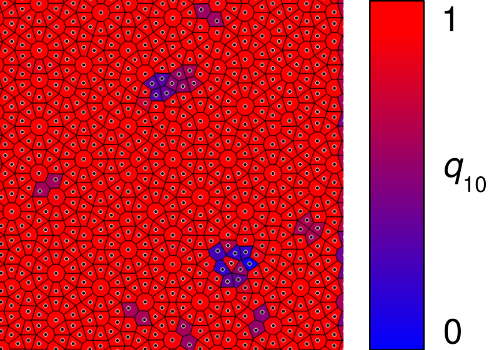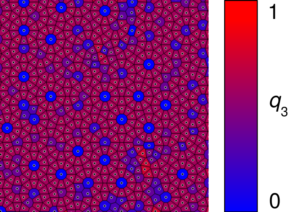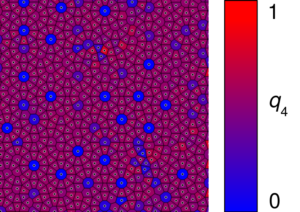Here we show how to employ Minkowski structure metrics to detect order in particle configurations.
Lennard-Jones-Gauß potentials are known to form decagonal quasicrystals in 2D [bibcite key=engel2007self-assembly]. These structures produce a scattering pattern much like normal crystals do, but are aperiodic (i.e. there is no repeating unit cell which generates the crystal by translation). In quasicrystals, non-crystallographic rotational symmetries are possible, like 10-fold axes in the example shown below. Given the ten-fold symmetry of the structures, all neighbors of a particle are located at multiples 360/10 = 36 degrees with respect to some given axis. Thus, in this quasicrystal, all the Voronoi cell’s normals point in these directions, which is why ![]() for all these!
for all these!
In the following image, each cell is colored according to its ![]() magnitude, with
magnitude, with ![]() being red and
being red and ![]() being blue.
being blue.


This snapshot is taken from a simulation at finite temperature [bibcite key=martinsons2019event-chain-qc], and thus has some defects in it, which appear as cells with ![]() (tinted blue).
(tinted blue).
The Voronoi diagram of the quasicrystal structure is richer than one of a conventional crystal. It contains various polygons, the most frequent of which are regular decagons, octagonal “cap tiles”, hexagonal “axe tiles” and “diamonds”, and trapezoids of specific shape. Any cell shape can be characterized using Minkowski structure metrics. The same configuration, with the ![]() and
and ![]() glasses on, looks like this:
glasses on, looks like this:


Clearly, the decagons have ![]() , while the other tiles each have some specific
, while the other tiles each have some specific ![]() and
and ![]() .
.
Several Minkowski structure metrics taken together can be used to fingerprint a given cell shape. For reference, we include the circle below, which has ![]() for all
for all ![]() . The quasicrystal tiles have the following characteristic
. The quasicrystal tiles have the following characteristic ![]() values:
values:
| Circle | 0.0000 | 0.0000 | 0.0000 | 0.0000 | 0.0000 | 0.0000 | 0.0000 | 0.0000 | 0.0000 |
| Decagon | 0.0000 | 0.0000 | 0.0000 | 0.0000 | 0.0000 | 0.0000 | 0.0000 | 0.0000 | 1.0000 |
| Diamond | 0.0669 | 0.4605 | 0.5669 | 0.0000 | 0.5669 | 0.4605 | 0.0669 | 0.0000 | 1.0000 |
| Trapezoid | 0.0698 | 0.6612 | 0.5914 | 0.4086 | 0.5914 | 0.6612 | 0.0698 | 0.0000 | 1.0000 |
| Cap tile | 0.1040 | 0.2325 | 0.3365 | 0.3762 | 0.3365 | 0.2325 | 0.1040 | 0.0000 | 1.0000 |
| Axe tile | 0.1752 | 0.3917 | 0.2165 | 0.7835 | 0.2165 | 0.3917 | 0.1752 | 0.0000 | 1.0000 |
If we plot the ![]() vs. the
vs. the ![]() value of each cell in a scatterplot, the typical cell types expected in a perfect decagonal quasicrystal can be readily identified:
value of each cell in a scatterplot, the typical cell types expected in a perfect decagonal quasicrystal can be readily identified:

The colour code shows ![]() again. Each of the five tile types listed above has
again. Each of the five tile types listed above has ![]() in its ideal configuration, identified by a black solid bullet. Around those, we find tiles which are slightly perturbed by thermal noise (still red in color as their
in its ideal configuration, identified by a black solid bullet. Around those, we find tiles which are slightly perturbed by thermal noise (still red in color as their ![]() ). The farther the tiles are located from the ideal cell shape in this plot, the more deformed they are.
). The farther the tiles are located from the ideal cell shape in this plot, the more deformed they are.
Datapoints far away from the bullets in bluish colour are defects which do not conform to the quasicrystal symmetry. These include the pentagonal tiles (![]() ) and quadrilateral kites (
) and quadrilateral kites (![]() ,
, ![]() ) which were already apparent as blue-tinted defects in Figure 1.
) which were already apparent as blue-tinted defects in Figure 1.